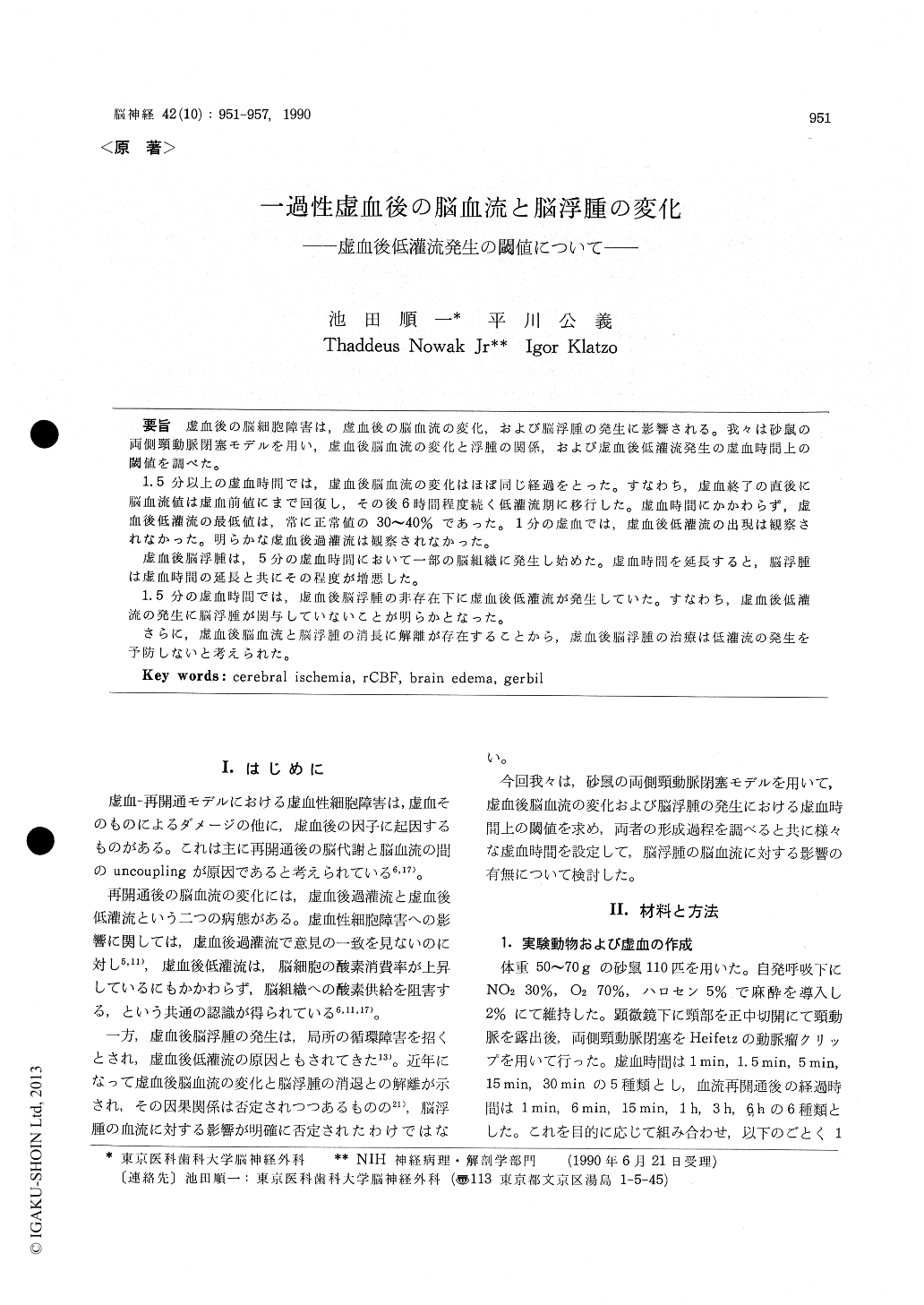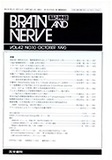Japanese
English
- 有料閲覧
- Abstract 文献概要
- 1ページ目 Look Inside
虚血後の脳細胞障害は,虚血後の脳血流の変化,および脳浮腫の発生に影響される。我々は砂鼠の両側頸動脈閉塞モデルを用い,虚血後脳血流の変化と浮腫の関係,および虚血後低灌流発生の虚血時間上の閾値を調べた。
1.5分以上の虚血時間では,虚血後脳血流の変化はほぼ同じ経過をとった。すなわち,虚血終了の直後に脳血流値は虚血前値にまで回復し,その後6時間程度続く低灌流期に移行した。虚血時間にかかわらず,虚血後低灌流の最低値は,常に正常値の30〜40%であった。1分の虚血では,虚血後低灌流の出現は観察されなかった。明らかな虚血後過灌流は観察されなかった。
虚血後脳浮腫は,5分の虚血時間において一部の脳組織に発生し始めた。虚血時間を延長すると,脳浮腫は虚血時間の延長と共にその程度が増悪した。
1.5分の虚血時間では,虚血後脳浮腫の非存在下に虚血後低灌流が発生していた。すなわち,虚血後低灌流の発生に脳浮腫が関与していないことが明らかとなった。
さらに,虚血後脳血流と脳浮腫の消長に解離が存在することから,虚血後脳浮腫の治療は低灌流の発生を予防しないと考えられた。
Brain damage after transient cerebral ischemia may be related to changes in postischemic cerebral blood flow and brain edema. In this study, the relationship between postischemic cerebral blood flow and edema was evaluated in the gerbil.
Bilateral carotid occlusion (for 1,1.5,5,15, or 30 min) was carried out in 110 female gerbils (50-70 g) under anesthesia with 2% halothane in 30% 02 and 70% NO2. Cerebral blood flow was measured by a [14C]-iodoantipyrine method modi-fied slightly for use in small animals, and brain edema was evaluated by a specific gravity method. The threshold duration of ischemia which gives rise to subsequent hypoperfusion or edema was also established. In another 52 female gerbils un-der the same anesthesia, we investigated the effect of ischemia of variable duration on postischemic blood pressure and blood gas.
Throughout all experiments, rectal temperature was maintained at 37-38°C with a heating pad. Student's t test was used to calculate statistical significance.
Neither blood pressure nor blood gas did vary significantly at any time following recirculation. Each brain region showed the same pattern of blood flow change, one almost independent of du-ration of occlusion. Namely, after the release of occlusion, transient recovery of blood flow was observed. But the flow then fell to 30,-40% of the normal value at 1 h, after which it returned up to normal at 6 h. The severity of postischemic hypoperfusion was also independent of occlusion time.
Interestingly, we did not observe postischemic hyperemia in any experimental groups except mild hyperemia in hippocampus after 5 and 15 min ischemia.
Hypoperfusion was not observed following is-chemia of less than 1 min duration but was re-producibly found after occlusions of 1.5 min or longer. Notably, there was no edema at any re-circulation time examined following 1.5 min oc-clusion, arguing against the involvement of tissue swelling and vascular compression in the patho-mechanism of postischemic hypoperfusion.
On the other hand, development of postischemic water accumulation started in some brain regions following 5 min ischemia and increased progres-sively with increasing duration of ischemia. In the case of 30-min occlusion, resolution of edema was not observed even at 6 h after ischemic insult.This discrepancy between postischemic develop-ment of edema and hypoperfusion suggests that treatment of postischemic brain edema itself does not improve the final outcome of an ischemic cell damage.

Copyright © 1990, Igaku-Shoin Ltd. All rights reserved.


